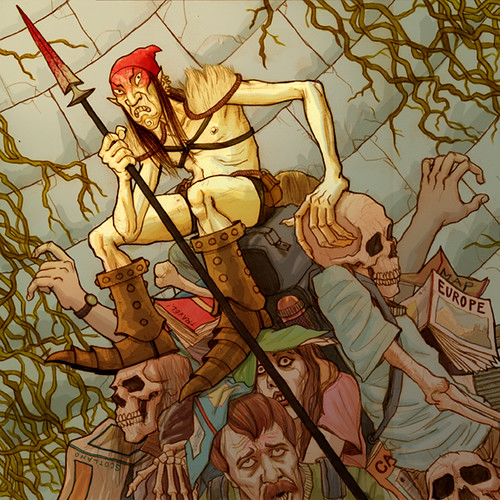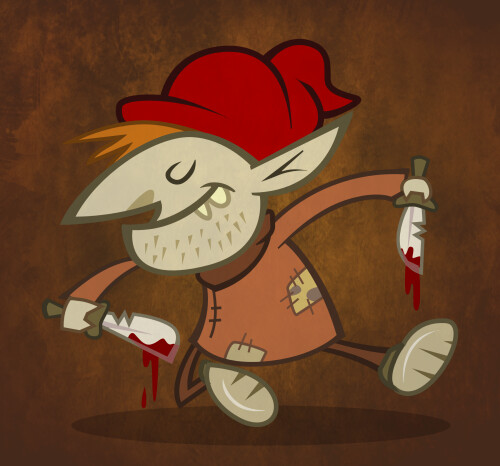For the unwary visitor to their lair, redcaps can be deeply dangerous creatures. These malevolent little folk are classified ‘goblins’ and that’s a word that’s rarely attached to anything positive. While they do appear in northern European folklore, they’re most often found in Border folklore.
In many ways, it’s hardly surprising. The Border region is a particularly blood-soaked part of the British Isles. The land was contested for centuries, though the redcaps appear in the castles in southern Scotland rather than northern England.
According to Sir Walter Scott, “Redcap is a popular appelation of that class of spirits which haunt old castles. Every ruined tower in the South of Scotland is supposed to have an inhabitant of this species” (quoted in Henderson 1879: 254).
Since they’re so dangerous, let’s find out more about them…
Where Do Redcaps Hang Out?
According to 19th-century folklorist William Henderson, redcaps live in the string of ruined castles stretching along the border between England and Scotland (1879: 253). They favour the castles that saw violent or tyrannical events—which in many ways should be most of them. Some believe the redcap’s name comes from his tendency to soak his cap in fresh blood, hence his alternative name, Bloody Cap.

Yet this bloody cap proves to be a weak spot for the redcaps. They can’t let the blood dry out because they will die if it does. This apparently explains the glee with which they kill, though I’m not sure where they find a steady supply of victims if they live in ruined castles.
Henderson even describes them: “He is depicted as a short thickset old man, with long prominent teeth, skinny fingers armed with talons like eagles, large eyes of a fiery-red colour, grisly hair streaming down his shoulders, iron boots, a pikestaff in his left hand, and a red cap on his head” (1879: 253).
The redcap would throw stones at anyone who tried to shelter in one of his castles, and where possible he killed them. He dipped his cap in their blood to keep the blood fresh.
Taking on a redcap is never recommended. Despite their iron boots, you’d be hard-pressed to outrun one. Only two possible defences pop up often in folklore.
You can either quote the Bible at him or hold up a Cross. Either of these actions should drive him away. If you’re successful, the redcap disappears with a yell in a flash of flames and leaves behind a large tooth.

‘Redcap Sly’
Perhaps the ‘main’ legend about a redcap concerns Hermitage Castle, near Newcastleton, Roxburghshire, Scotland. Built by Nicholas de Soulis in around 1240, by 1320 it had passed to his descendant, William de Soulis. In the legends, Lord Soulis was no ordinary landowner. Apparently, he practised the black arts and was a keen sorcerer.
J. Levden describes him following “local tradition” as “uniting every quality which could render strength formidable, and cruelty detestable” (1846: 163). Don’t hold back there!
As part of his sorcery, he conjured a redcap as a familiar. Some tales name him Robin Redcap, but William Henderson refers to him as Redcap Sly. Either way, Redcap Sly rampaged around William’s lands. Sir Walter Scott collected a Scottish ballad about the pair, and in it, Robin lives in a chest and enchants William.

The redcap noted that he’d have a charmed life, and he’d be impervious to lances, arrows, swords and knives. Only three ropes made of sifted sand wrapped around his body would be his downfall (Henderson 1879: 254). It’s interesting that the redcap only seems to consider bladed or pointed weapons as potentially dangerous. Whether this is due to their being composed of metal, given the fairies’ general dislike for iron, is unclear.
In the legends, Lord Soulis does indeed meet his end in a most grisly fashion. He was boiled to death in a cauldron at Ninestane Rig, a nearby megalithic circle. Redcap Sly is unable to save him since his captors don’t use metal weapons.
Levden also claims that Robert Bruce condemned him to death by saying “Boil him if you please, but let me hear no more of him” following repeated complaints about William’s outlandish behaviour (1846: 163). According to this version of the legend, Bruce dispatched riders to prevent the execution from taking place after realising his words had been taken seriously. They were too late.
As is so often the way with these things, the legend is more fanciful than the truth. William ended his days in Dumbarton Castle, after confessing his part in a 1320 conspiracy against Robert Bruce. He forfeited the castle as a result. Still, it’s interesting that Levden’s version of the tale focuses on the accusations of sorcery. It makes no mention of Redcap Sly. Instead, the redcap appears in the ballad about it collected by Sir Walter Scott.
You can still visit Hermitage Castle. Historic Environment Scotland cares for it, and it’s open between 1 April and 30 September. It’s also believed to be haunted by Mary, Queen of Scots.

Other Redcaps in Folklore
Henderson notes the parallel existence of the dunter or powrie in similar Border ruins. These noisy sprites make sounds like beating flax. Apparently, if the sound goes on longer than usual, or is louder, it predicts a death (1879: 255).
According to Henderson, the Picts who built the Border castles used human blood to purify the foundation stones (1879: 256). This grisly act created resident ghosts in the buildings; some wonder if the spirits of these sacrifices take the form of redcaps or dunters. If so, it would be interesting to know how Lord Soulis managed to conjure one as a familiar.
Redcaps pop up elsewhere in folklore, as folkloric creatures often do. While the Border redcaps favour blood and destruction, a Perthshire redcap in Grantully Castle showers anyone who sees him with good fortune (Briggs 1976: 339).
Vampires.com say redcaps also appear in Ireland, calling them “the vampire’s cousin”. They also say the cap is made from dried human skin.
The Dutch redcaps, known as Kaboutermannekin, are completely different from their Scottish namesakes. The Dutch redcaps wear “red from head to foot” and carry out tasks around the house. One of these sounds remarkably helpful in that they light invisible fires during the night that still warm the house (Henderson 1879: 255). William Henderson notes that these redcaps help out around the house, and “on receiving new clothes vanishes never to return” (1879: 250). This brings them closer to traditional brownie lore than the bloodthirsty Border variety.

Henderson actually relates a tale from Kempnerland in which a miller tried to get his former redcap back. Having given him clothes as a reward, he missed his servant. He knew that the Kaboutermannekin crossed a particular bridge every evening, so he lay in wait. A procession of them passed over the bridge, with his former sprite bringing up the rear. He still proudly wore his new clothes. The miller pounced, trying to grab the redcap. A voice, sounding remarkably like his wife, cried for help from the river, so the miller turned away. The Kaboutermannekin all vanished (1879: 250). It’s a far cry indeed from the Scottish Redcap.
What do we make of these redcaps?
Redcaps are by far some of the most malicious creatures in folklore, at least in the British Isles. Luckily, their association with ruined towers and castles mean that reports of them are few and far between.
This does of course raise the possibility that redcaps became cautionary tales to warn travellers away from lonely locations. After all, this was a violent part of the country where you could encounter threats other than redcaps.
Still, if you find yourself in the presence of a redcap, don’t try to run. Hold up a crucifix if you have one (or make one using two long objects, Peter Cushing-style). Quote scripture, if you know any.
With any luck, he’ll disappear and you can come back here to tell me all about it!
Have you heard of redcaps before? Let me know below!
References
Briggs, Katharine (1976), A Dictionary of Fairies: Hobgoblins, Brownies, Bogies, and Other Supernatural Creatures, London: Penguin Books.
Henderson, William (1879), Notes on the folk-lore of the northern counties of England and the borders, London: W. Satchell, Peyton and Co.
Levden, J. (1846), ‘The Cout of Keelder’, in M. A. Richardson (ed), The Borderer’s table book; or, Gatherings of the local history and romance of the English and Scottish Border, Volume II, London: Henry G. Bohn, pp. 162-171.
Nutty about folklore and want more?
Add your email below and get these posts in your inbox every week.
You'll also get my 5-step guide to protecting your home using folklore!








I know someone who saw one at the edge of a forest in Northern England. It was dressed in brown with a dark red cap. The guy was on a camping trip with friends, and stuck his nose out of the tent on a misty morning. He saw this odd little figure and was scared to death!
The Creature called a Redcap in Scottish folklore originally did not pertain to just “any fairy” wearing a red cap! They were malicious killers of humans who crossed their path.
“Redcap” was A word that immediately instilled fear in those that heard it and had Nothing to do with friendly Faerie folk such as house and garden gnomes who just happen to also wear red hats.
Redcaps and gnomes are not mentioned together, or thought of being related to one another in any story told by people of ancient times.
The “original” stories of the redcap likened them to the wailing woman or banshee. If you saw or heard one you were as good as dead!
While the post was largely about the Border variety of the redcap, it would be remiss not to mention the other types of fairy also referred to as ‘redcaps’. Other folklorists did mention the Dutch variety in particular and I felt it was worth including them to show the difference between the two types. As for the garden gnome image, I was simply struggling for a public domain image to go with the article. Apologies if that came across as confusing.
How can you rid yourself of a redcap curse or hex? Please help
I’ve never heard anything about Redcaps cursing anyone.
I’d be interested to know if you found a solution to this Lara. It seems they aren’t restricted to castles.